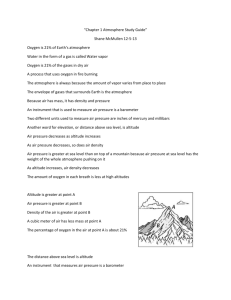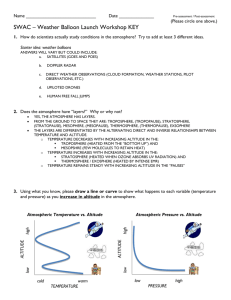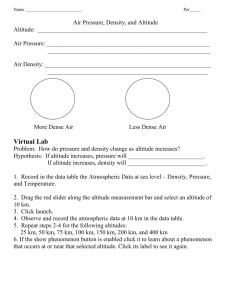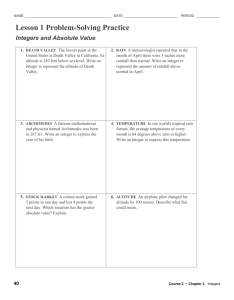Where Does The Atmosphere End And Outer
advertisement
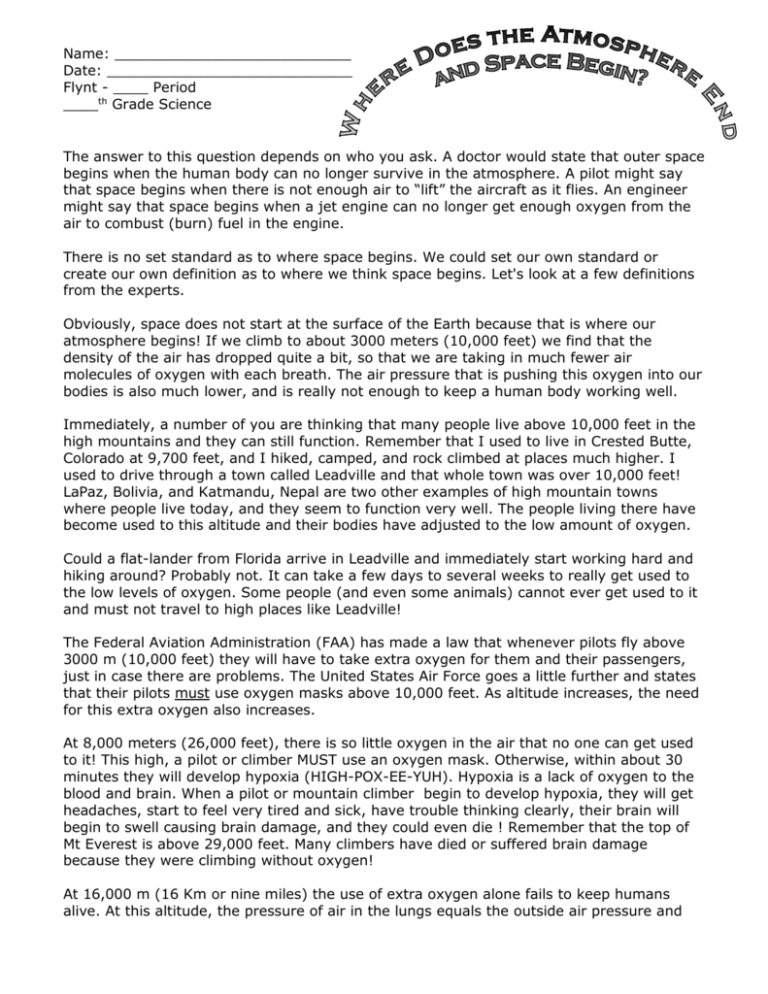
Name: ___________________________ Date: ____________________________ Flynt - ____ Period ____th Grade Science The answer to this question depends on who you ask. A doctor would state that outer space begins when the human body can no longer survive in the atmosphere. A pilot might say that space begins when there is not enough air to “lift” the aircraft as it flies. An engineer might say that space begins when a jet engine can no longer get enough oxygen from the air to combust (burn) fuel in the engine. There is no set standard as to where space begins. We could set our own standard or create our own definition as to where we think space begins. Let's look at a few definitions from the experts. Obviously, space does not start at the surface of the Earth because that is where our atmosphere begins! If we climb to about 3000 meters (10,000 feet) we find that the density of the air has dropped quite a bit, so that we are taking in much fewer air molecules of oxygen with each breath. The air pressure that is pushing this oxygen into our bodies is also much lower, and is really not enough to keep a human body working well. Immediately, a number of you are thinking that many people live above 10,000 feet in the high mountains and they can still function. Remember that I used to live in Crested Butte, Colorado at 9,700 feet, and I hiked, camped, and rock climbed at places much higher. I used to drive through a town called Leadville and that whole town was over 10,000 feet! LaPaz, Bolivia, and Katmandu, Nepal are two other examples of high mountain towns where people live today, and they seem to function very well. The people living there have become used to this altitude and their bodies have adjusted to the low amount of oxygen. Could a flat-lander from Florida arrive in Leadville and immediately start working hard and hiking around? Probably not. It can take a few days to several weeks to really get used to the low levels of oxygen. Some people (and even some animals) cannot ever get used to it and must not travel to high places like Leadville! The Federal Aviation Administration (FAA) has made a law that whenever pilots fly above 3000 m (10,000 feet) they will have to take extra oxygen for them and their passengers, just in case there are problems. The United States Air Force goes a little further and states that their pilots must use oxygen masks above 10,000 feet. As altitude increases, the need for this extra oxygen also increases. At 8,000 meters (26,000 feet), there is so little oxygen in the air that no one can get used to it! This high, a pilot or climber MUST use an oxygen mask. Otherwise, within about 30 minutes they will develop hypoxia (HIGH-POX-EE-YUH). Hypoxia is a lack of oxygen to the blood and brain. When a pilot or mountain climber begin to develop hypoxia, they will get headaches, start to feel very tired and sick, have trouble thinking clearly, their brain will begin to swell causing brain damage, and they could even die ! Remember that the top of Mt Everest is above 29,000 feet. Many climbers have died or suffered brain damage because they were climbing without oxygen! At 16,000 m (16 Km or nine miles) the use of extra oxygen alone fails to keep humans alive. At this altitude, the pressure of air in the lungs equals the outside air pressure and the extra oxygen alone cannot push its way into the blood without additional pressure. Therefore, the pilot and passengers must be in a pressurized (PRESH-UR-IZED) cabin or wear a special pressure suit to help force the air into the lungs. Most big planes have a pressurized cabin that draws in thin air from outside and presses it together so that we can breathe it. At 20 Km (12 miles), bubbles of water vapor and other gases begin to form in the body. The liquids in your body begin to literally boil, not because of heat, but because there is not enough pressure! You MUST be in a pressurized plane or a special pressure suit (similar to what the astronauts wear) to protect you from this violent condition! At 24 Km (15 miles), you reach the ozone layer in the atmosphere. Remember that ozone consists of three atoms of oxygen per molecule. Even though it is a type of oxygen, ozone is poisonous to the human body! Taking in air from outside the plane and compressing it would poison the plane and its occupants. At this altitude, the plane or space suit must have its own pressure system AND its own tank of pure oxygen – it cannot take any oxygen in from outside. For the human body, space begins at this point because above this altitude, a human must carry everything it needs in order for the body to survive. This is probably the doctor's definition of where space begins. At 32 Km (20 miles) turbo jets on a big plane can no longer function. Turbo jets take in air and compress it by means of huge fans to mix it with fuel for combustion – remember that fuel needs oxygen to burn! At 32 Km there is so little oxygen that the turbo jets cannot compress enough oxygen for mixing with the fuel. Above this altitude, aircraft must use special ramjets. A ramjet operates similar to a turbo jet except that a ram jet compresses air using super-sonic shock-waves rather than fans. The shockwave compresses the air much better than the fans on a turbojet. At 45 Km (28 miles) there is not enough air even for a ramjet to operate. Above this altitude, any aircraft must not only provide oxygen for passengers, but must also provide its own huge oxygen tank for combustion (known as an oxidizer) as well as fuel. This type of aircraft is called a rocket. To a propulsion (PRO-PUHL-SHUN) engineer, space begins above this altitude. At 81 KM (50 miles) one government agency, the United States Department of Defense, says that space begins. It awards all pilots who fly above this altitude astronaut wings. This group not only includes all the people who have flown the space shuttle and various other craft into space, but also the X-15 pilots who flew above this altitude. At 100 Km (62 miles) there is not enough air to lift or steer a plane. The rudder, the flaps, and the spoilers are no longer effective because there is not enough air to either lift or drag on them to turn or steer the plane. At this altitude space is dark; the stars no longer shimmer, but are hard points of light. There is no sound – no sonic booms, no explosions, no shockwaves can be heard in space. Surely, you say, some international body must have declared where space begins. International law states that there is no definite point where the atmosphere ends and space begins. Where does space begin? What do you think? Name: ___________________________ Date: ____________________________ Flynt - ____ Period ____th Grade Science 1. Describe how the density of the atmosphere changes with altitude and draw a diagram showing how the number of air molecules changes. 2. What are two places where people live above 10,000 feet? 3. Many people live and work above 10,000 feet. With this in mind, why do you think the FAA requires all planes flying above 10,000 to carry extra oxygen for their passengers? 4. Describe the conditions and situations that can lead to hypoxia. Describe associated symptoms and how it can make you feel. 5. In your reading, you learned that a pilot must wear a special pressure suit to help force air into their lungs when they travel higher than 16 km above the Earth. Explain why a just having an oxygen mask won’t work at this altitude. 6. Imagine what a pressure suit might look like. Carefully draw and label a detailed picture of your own version of what a pressure suit might look like, illustrating how this suit like this might work. Be sure to use your creativity and imagination (as well as a ruler and colored pencils)! 7. Moving on up, describe what happens to your body 20 km (12 miles) above sea level if you were not wearing your pressurized suit (pictured above). What layer of the atmosphere are you in if you are this high? 8. A doctor might argue that the atmosphere ends and space begins around ______ km above the Earth. What evidence would they use to support their claim? Don’t forget to fill in the blank above! 9. Where does the United States Department of Defense say that space begins? What would you receive from them if you flew at that altitude? 10. Where do you think space begins? Discuss what criteria you think should be used to determine the Earth/Space boundary.
